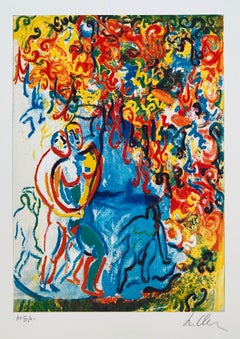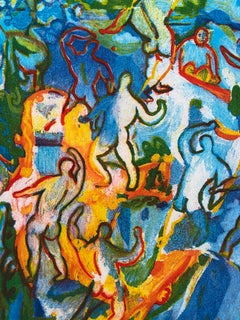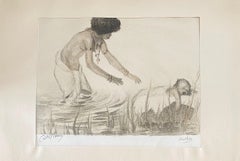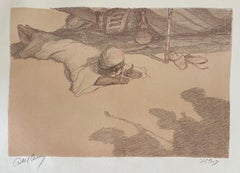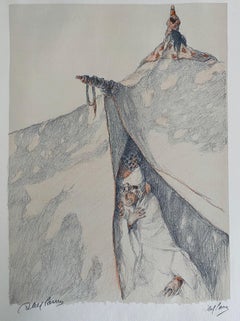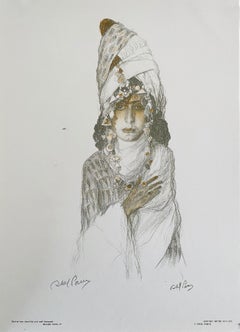Lions Gallery Prints and Multiples
to
376
323
370
111
35
Overall Width
to
Overall Height
to
300
162
120
103
98
93
15
10
7
3
2
2
38
30
29
24
24
2
1,167
46
1
12
24
21
20
155
175
159
109
790
366
56
145
77
73
58
53
36
29
28
19
18
12
10
8
5
5
5
5
5
5
5
581
284
195
104
79
32
1
1,215
Lithograph Italian Post Modernist Figurative Pop Art
By Sandro Chia
Located in Surfside, FL
Sandro Chia was born in Florence in 1946. He has studied at the Istituto d’Arte and then at the Accademia di Belle Arti in Florence where he graduated in 1969. After graduation, he h...
Category
Late 20th Century Pop Art Figurative Prints
Materials
Lithograph
Lithograph Italian Post Modernist Figurative Pop Art
By Sandro Chia
Located in Surfside, FL
Sandro Chia was born in Florence in 1946. He has studied at the Istituto d’Arte and then at the Accademia di Belle Arti in Florence where he graduated in 1969. After graduation, he h...
Category
Late 20th Century Pop Art Figurative Prints
Materials
Lithograph
Abel Pann Israeli Bezalel School Lithograph Judaica Biblical Print Jewish Art
By Abel Pann
Located in Surfside, FL
Abel Pann (1883–1963) was a European Jewish painter who settled in the Talpiot neighborhood of Jerusalem in the early twentieth century and taught at the Bezalel Academy of Art under...
Category
Mid-20th Century Symbolist Figurative Prints
Materials
Lithograph
Abel Pann Israeli Bezalel School Lithograph Judaica Biblical Print Jewish Art
By Abel Pann
Located in Surfside, FL
Abel Pann (1883–1963) was a European Jewish painter who settled in the Talpiot neighborhood of Jerusalem in the early twentieth century and taught at the Bezalel Academy of Art under...
Category
Mid-20th Century Symbolist Figurative Prints
Materials
Lithograph
Abel Pann Israeli Bezalel School Lithograph Judaica Biblical Print Jewish Art
By Abel Pann
Located in Surfside, FL
Abel Pann (1883–1963) was a European Jewish painter who settled in the Talpiot neighborhood of Jerusalem in the early twentieth century and taught at the Bezalel Academy of Art under...
Category
Mid-20th Century Symbolist Figurative Prints
Materials
Lithograph
Abel Pann Israeli Bezalel School Lithograph Judaica Biblical Print Jewish Art
By Abel Pann
Located in Surfside, FL
Abel Pann (1883–1963) was a European Jewish painter who settled in the Talpiot neighborhood of Jerusalem in the early twentieth century and taught at the Bezalel Academy of Art under...
Category
Mid-20th Century Symbolist Figurative Prints
Materials
Lithograph
Abel Pann Israeli Bezalel School Lithograph Judaica Biblical Print Jewish Art
By Abel Pann
Located in Surfside, FL
Abel Pann (1883–1963) was a European Jewish painter who settled in the Talpiot neighborhood of Jerusalem in the early twentieth century and taught at the Bezalel Academy of Art under...
Category
Mid-20th Century Symbolist Figurative Prints
Materials
Lithograph
Abel Pann Israeli Bezalel School Lithograph Judaica Biblical Print Jewish Art
By Abel Pann
Located in Surfside, FL
Abel Pann (1883–1963) was a European Jewish painter who settled in the Talpiot neighborhood of Jerusalem in the early twentieth century and taught at the Bezalel Academy of Art under...
Category
Mid-20th Century Symbolist Figurative Prints
Materials
Lithograph
Abel Pann Israeli Bezalel School Lithograph Judaica Biblical Print Jewish Art
By Abel Pann
Located in Surfside, FL
Abel Pann (1883–1963) was a European Jewish painter who settled in the Talpiot neighborhood of Jerusalem in the early twentieth century and taught at the Bezalel Academy of Art under...
Category
Mid-20th Century Symbolist Figurative Prints
Materials
Lithograph
Abel Pann Israeli Bezalel School Lithograph Judaica Biblical Print Jewish Art
By Abel Pann
Located in Surfside, FL
Abel Pann (1883–1963) was a European Jewish painter who settled in the Talpiot neighborhood of Jerusalem in the early twentieth century and taught at the Bezalel Academy of Art under...
Category
Mid-20th Century Symbolist Figurative Prints
Materials
Lithograph
Abel Pann Israeli Bezalel School Lithograph Judaica Biblical Print Jewish Art
By Abel Pann
Located in Surfside, FL
Abel Pann (1883–1963) was a European Jewish painter who settled in the Talpiot neighborhood of Jerusalem in the early twentieth century and taught at the Bezalel Academy of Art under...
Category
Mid-20th Century Symbolist Figurative Prints
Materials
Lithograph
Abel Pann Israeli Bezalel School Lithograph Judaica Biblical Print Jewish Art
By Abel Pann
Located in Surfside, FL
Abel Pann (1883–1963) was a European Jewish painter who settled in the Talpiot neighborhood of Jerusalem in the early twentieth century and taught at the Bezalel Academy of Art under...
Category
Mid-20th Century Symbolist Figurative Prints
Materials
Lithograph
Abel Pann Israeli Bezalel School Lithograph Judaica Biblical Print Jewish Art
By Abel Pann
Located in Surfside, FL
Abel Pann (1883–1963) was a European Jewish painter who settled in the Talpiot neighborhood of Jerusalem in the early twentieth century and taught at the Bezalel Academy of Art under...
Category
Mid-20th Century Symbolist Figurative Prints
Materials
Lithograph
Abel Pann Israeli Bezalel School Lithograph Judaica Biblical Print Jewish Art
By Abel Pann
Located in Surfside, FL
Abel Pann (1883–1963) was a European Jewish painter who settled in the Talpiot neighborhood of Jerusalem in the early twentieth century and taught at the Bezalel Academy of Art under...
Category
Mid-20th Century Symbolist Figurative Prints
Materials
Lithograph
Abel Pann Israeli Bezalel School Lithograph Judaica Biblical Print Jewish Art
By Abel Pann
Located in Surfside, FL
Abel Pann (1883–1963) was a European Jewish painter who settled in the Talpiot neighborhood of Jerusalem in the early twentieth century and taught at the Bezalel Academy of Art under...
Category
Mid-20th Century Symbolist Figurative Prints
Materials
Lithograph
Abel Pann Israeli Bezalel School Lithograph Judaica Biblical Print Jewish Art
By Abel Pann
Located in Surfside, FL
Abel Pann (1883–1963) was a European Jewish painter who settled in the Talpiot neighborhood of Jerusalem in the early twentieth century and taught at the Bezalel Academy of Art under...
Category
Mid-20th Century Symbolist Figurative Prints
Materials
Lithograph
Abel Pann Israeli Bezalel School Lithograph Judaica Biblical Print Jewish Art
By Abel Pann
Located in Surfside, FL
Abel Pann (1883–1963) was a European Jewish painter who settled in the Talpiot neighborhood of Jerusalem in the early twentieth century and taught at the Bezalel Academy of Art under...
Category
Mid-20th Century Symbolist Figurative Prints
Materials
Lithograph
Abel Pann Israeli Bezalel School Lithograph Judaica Biblical Print Jewish Art
By Abel Pann
Located in Surfside, FL
Abel Pann (1883–1963) was a European Jewish painter who settled in the Talpiot neighborhood of Jerusalem in the early twentieth century and taught at the Bezalel Academy of Art under...
Category
Mid-20th Century Symbolist Figurative Prints
Materials
Lithograph
Abel Pann Israeli Bezalel School Lithograph Judaica Biblical Print Jewish Art
By Abel Pann
Located in Surfside, FL
Abel Pann (1883–1963) was a European Jewish painter who settled in the Talpiot neighborhood of Jerusalem in the early twentieth century and taught at the Bezalel Academy of Art under...
Category
Mid-20th Century Symbolist Figurative Prints
Materials
Lithograph
Abel Pann Israeli Bezalel School Lithograph Judaica Biblical Print Jewish Art
By Abel Pann
Located in Surfside, FL
Abel Pann (1883–1963) was a European Jewish painter who settled in the Talpiot neighborhood of Jerusalem in the early twentieth century and taught at the Bezalel Academy of Art under...
Category
Mid-20th Century Symbolist Figurative Prints
Materials
Lithograph
Abel Pann Israeli Bezalel School Lithograph Judaica Biblical Print Jewish Art
By Abel Pann
Located in Surfside, FL
Abel Pann (1883–1963) was a European Jewish painter who settled in the Talpiot neighborhood of Jerusalem in the early twentieth century and taught at the Bezalel Academy of Art under...
Category
Mid-20th Century Symbolist Figurative Prints
Materials
Lithograph
Abel Pann Israeli Bezalel School Lithograph Judaica Biblical Print Jewish Art
By Abel Pann
Located in Surfside, FL
Abel Pann (1883–1963) was a European Jewish painter who settled in the Talpiot neighborhood of Jerusalem in the early twentieth century and taught at the Bezalel Academy of Art under...
Category
Mid-20th Century Symbolist Figurative Prints
Materials
Lithograph
Abel Pann Israeli Bezalel School Lithograph Judaica Biblical Print Jewish Art
By Abel Pann
Located in Surfside, FL
Abel Pann (1883–1963) was a European Jewish painter who settled in the Talpiot neighborhood of Jerusalem in the early twentieth century and taught at the Bezalel Academy of Art under...
Category
Mid-20th Century Symbolist Figurative Prints
Materials
Lithograph
Abel Pann Israeli Bezalel School Lithograph Judaica Biblical Print Jewish Art
By Abel Pann
Located in Surfside, FL
Abel Pann (1883–1963) was a European Jewish painter who settled in the Talpiot neighborhood of Jerusalem in the early twentieth century and taught at the Bezalel Academy of Art under...
Category
Mid-20th Century Symbolist Figurative Prints
Materials
Lithograph
Abel Pann Israeli Bezalel School Lithograph Judaica Biblical Print Jewish Art
By Abel Pann
Located in Surfside, FL
Abel Pann (1883–1963) was a European Jewish painter who settled in the Talpiot neighborhood of Jerusalem in the early twentieth century and taught at the Bezalel Academy of Art under...
Category
Mid-20th Century Symbolist Figurative Prints
Materials
Lithograph
Abel Pann Israeli Bezalel School Lithograph Judaica Biblical Print Jewish Art
By Abel Pann
Located in Surfside, FL
Abel Pann (1883–1963) was a European Jewish painter who settled in the Talpiot neighborhood of Jerusalem in the early twentieth century and taught at the Bezalel Academy of Art under...
Category
Mid-20th Century Symbolist Figurative Prints
Materials
Lithograph
Abel Pann Israeli Bezalel School Lithograph Judaica Biblical Print Jewish Art
By Abel Pann
Located in Surfside, FL
Abel Pann (1883–1963) was a European Jewish painter who settled in the Talpiot neighborhood of Jerusalem in the early twentieth century and taught at the Bezalel Academy of Art under...
Category
Mid-20th Century Symbolist Figurative Prints
Materials
Lithograph
Abel Pann Israeli Bezalel School Lithograph Judaica Biblical Print Jewish Art
By Abel Pann
Located in Surfside, FL
Abel Pann (1883–1963) was a European Jewish painter who settled in the Talpiot neighborhood of Jerusalem in the early twentieth century and taught at the Bezalel Academy of Art under...
Category
Mid-20th Century Symbolist Figurative Prints
Materials
Lithograph
Abel Pann Israeli Bezalel School Lithograph Judaica Biblical Print Jewish Art
By Abel Pann
Located in Surfside, FL
Abel Pann (1883–1963) was a European Jewish painter who settled in the Talpiot neighborhood of Jerusalem in the early twentieth century and taught at the Bezalel Academy of Art under...
Category
Mid-20th Century Symbolist Figurative Prints
Materials
Lithograph
Abel Pann Israeli Bezalel School Lithograph Judaica Biblical Print Jewish Art
By Abel Pann
Located in Surfside, FL
Abel Pann (1883–1963) was a European Jewish painter who settled in the Talpiot neighborhood of Jerusalem in the early twentieth century and taught at the Bezalel Academy of Art under...
Category
Mid-20th Century Symbolist Figurative Prints
Materials
Lithograph
Abel Pann Israeli Bezalel School Lithograph Judaica Biblical Print Jewish Art
By Abel Pann
Located in Surfside, FL
Abel Pann (1883–1963) was a European Jewish painter who settled in the Talpiot neighborhood of Jerusalem in the early twentieth century and taught at the Bezalel Academy of Art under...
Category
Mid-20th Century Symbolist Figurative Prints
Materials
Lithograph
Abel Pann Israeli Bezalel School Lithograph Judaica Biblical Print Jewish Art
By Abel Pann
Located in Surfside, FL
Abel Pann (1883–1963) was a European Jewish painter who settled in the Talpiot neighborhood of Jerusalem in the early twentieth century and taught at the Bezalel Academy of Art under...
Category
Mid-20th Century Symbolist Figurative Prints
Materials
Lithograph
Abel Pann Israeli Bezalel School Lithograph Judaica Biblical Print Jewish Art
By Abel Pann
Located in Surfside, FL
Abel Pann (1883–1963) was a European Jewish painter who settled in the Talpiot neighborhood of Jerusalem in the early twentieth century and taught at the Bezalel Academy of Art under...
Category
Mid-20th Century Symbolist Figurative Prints
Materials
Lithograph
Abel Pann Israeli Bezalel School Lithograph Judaica Biblical Print Jewish Art
By Abel Pann
Located in Surfside, FL
Abel Pann (1883–1963) was a European Jewish painter who settled in the Talpiot neighborhood of Jerusalem in the early twentieth century and taught at the Bezalel Academy of Art under...
Category
Mid-20th Century Symbolist Figurative Prints
Materials
Lithograph
Abel Pann Israeli Bezalel School Lithograph Judaica Biblical Print Jewish Art
By Abel Pann
Located in Surfside, FL
Abel Pann (1883–1963) was a European Jewish painter who settled in the Talpiot neighborhood of Jerusalem in the early twentieth century and taught at the Bezalel Academy of Art under...
Category
Mid-20th Century Symbolist Figurative Prints
Materials
Lithograph
Abel Pann Israeli Bezalel School Lithograph Judaica Biblical Print Jewish Art
By Abel Pann
Located in Surfside, FL
Abel Pann (1883–1963) was a European Jewish painter who settled in the Talpiot neighborhood of Jerusalem in the early twentieth century and taught at the Bezalel Academy of Art under...
Category
Mid-20th Century Symbolist Figurative Prints
Materials
Lithograph
Abel Pann Israeli Bezalel School Lithograph Judaica Biblical Print Jewish Art
By Abel Pann
Located in Surfside, FL
Abel Pann (1883–1963) was a European Jewish painter who settled in the Talpiot neighborhood of Jerusalem in the early twentieth century and taught at the Bezalel Academy of Art under...
Category
Mid-20th Century Symbolist Figurative Prints
Materials
Lithograph
Abel Pann Israeli Bezalel School Lithograph Judaica Biblical Print Jewish Art
By Abel Pann
Located in Surfside, FL
Abel Pann (1883–1963) was a European Jewish painter who settled in the Talpiot neighborhood of Jerusalem in the early twentieth century and taught at the Bezalel Academy of Art under...
Category
Mid-20th Century Symbolist Figurative Prints
Materials
Lithograph
Abel Pann Israeli Bezalel School Lithograph Judaica Biblical Print Jewish Art
By Abel Pann
Located in Surfside, FL
Abel Pann (1883–1963) was a European Jewish painter who settled in the Talpiot neighborhood of Jerusalem in the early twentieth century and taught at the Bezalel Academy of Art under...
Category
Mid-20th Century Symbolist Figurative Prints
Materials
Lithograph
Israeli Abstract Modernist Aquatint Screenprint Color Photo-Etching
By Asaf Ben Tzvi
Located in Surfside, FL
SHIPS THAT PASS IN THE NIGHT, (Barcos que Passan na Noite)
1999, color screenprint, signed in pencil, numbered 1/60, sheet 22 ½ x 27 ½”.
From Jerusalem print workshop.
Asaf Ben Zvi, Israeli contemporary artist, was born in Kfar Yehezkel, Israel, 1953. Studied at the Bezalel Academy of Arts and Design, Jerusalem and the Pratt Institute, New York. Laureate of numerous awards, notably the Rappaport Prize for an Established Artist for 2011, Tel Aviv Museum of Art. Lives and works in Jerusalem.
He did his army service in a commando unit and fought in the Yom Kippur War. After his discharge from the army he settled in Jerusalem and became interested in bird-watching. In 1981 he began to study architecture at Bezalel, but transferred to the art department. During the period of his studies, he worked primarily in sculpture, but after a period of study in New York, he began to paint as well. From the mid-1980s he made use of simple figures, so abstracted in their form that they became symbolic figures. Some of these figures were connected to biographical baggage, while others were based on trivial events. Many of his works are based on poetic texts that show his interest in esthetics and in the relationship between the painter and society.
Education
1981-1985 Bezalel School of Art and Design, Jerusalem, BFA
1985 Pratt Institute, New York.City, USA
Teaching
1933 Bezalel School of Art and Design, Jerusalem.
Since 1989 Kalisher School, Tel Aviv.
Awards And Prizes
1981-82, The America-Israel Cultural Foundation, Sharett Fund Grant
1982-83, The America-Israel Cultural Foundation, Sharett Fund Grant
1987 Beatrice Kolliner Prize for a Young Israeli Artist, Israel Museum, Jerusalem
1989 Mendel Pundik Prize for Israeli Art, Tel Aviv Museum of Art, Tel Aviv
1991 Rafael and Hadassah Klatchkin Prize, America-Israel Cultural Foundation
1992 Prize for Plastic Arts, Ministry of Education
1994 Bank Discount Prize for an Israeli Artist, Israel Museum, Jerusalem
1997 Eugene Kolb Prize for Israeli Graphic Arts, Tel Aviv Museum of Art, Tel Aviv
2011 Prize for an Established Israeli Artist, Tel Aviv Museum of Art, Tel Aviv
Environmental Sculptures
1982 Tel-Haisaf Ben Zvi was involved in ornithology until the early 1990s. In 1981, he enrolled in the Art department at Israel’s Bezalel Academy of Arts and Design. During his studies, he participated in a student exchange program at the Pratt Institute in New York. From the outset, Ben Zvi’s focus has been on nature and the environment. Ecological and human disasters and natural disasters initially played an main role in his work and received expression through various fields of color, with motifs such as a cross, a water flask, a wasp, butterfly or bird, symbolizing the fragile human existence steeped in an eternal struggle.
In his later work, words penetrate the space of his paintings and art, reflecting on the private, public, local and universal realms. "Ben Zvi at his best is a visual poet, one who places words with great sensitivity to their tone and sometimes relinquishes the splendor of an image in favor of text and message."
The Printer's Imprint: Twenty Years with the Jerusalem Print Workshop, Jerusalem
Israel Museum, Jerusalem 15 November, 1994 - 14 February, 1995
Artists: Avraham Ofek, Fima (Roytenberg, Ephraim), Michael Kovner...
Category
1990s Abstract Abstract Prints
Materials
Aquatint, Screen
Simka Simkhovitch WPA Artist Lithograph Island Beach 1933 American Modernist
By Simka Simkhovitch
Located in Surfside, FL
Simka Simkhovitch (Russian/American 1893 - 1949) signed lithograph. Pencil signed and dated "S. Simkhovitch 1933" lower center. Title "Island Beach,"...
Category
1930s American Modern Landscape Prints
Materials
Lithograph
Italian Artist Modern Silkscreen Eugenio Carmi
By Eugenio Carmi
Located in Surfside, FL
Eugenio Carmi is an Italian painter born in 1920 in Genoa. He studied in Turin in Felice Casorati’s studio. His experience as a graphic designer in the ‘50s, is decisive for his pict...
Category
1980s Modern Abstract Prints
Materials
Screen
Female American Abstract Expressionist Artist Color Monoprint Melissa Meyer
By Melissa Meyer
Located in Surfside, FL
Melissa Meyer (born May 4, 1946) is an American artist and painter. The Wall Street Journal has referred to her as a "lighthearted Abstract Expressionist". She works in various forma...
Category
Late 20th Century Abstract Expressionist Prints and Multiples
Materials
Monoprint
American Artist Handmade Multi Colored Paper With Collage Steven Sorman
By Steven Sorman
Located in Surfside, FL
Steven Sorman was born in Minneapolis, Minnesota in 1948. Internationally known as a painter and printmaker, Sorman earned his Bachelor of Fine Arts degree from University of Minneso...
Category
21st Century and Contemporary Contemporary Prints and Multiples
Materials
Handmade Paper, Monoprint
Abel Pann Israeli Bezalel School Lithograph Judaica Biblical Print Jewish Art
By Abel Pann
Located in Surfside, FL
Abel Pann (1883–1963) was a European Jewish painter who settled in the Talpiot neighborhood of Jerusalem in the early twentieth century and taught at the Bezalel Academy of Art under...
Category
Mid-20th Century Symbolist Figurative Prints
Materials
Lithograph
American Artist Contemporary Etching Tom Butter Cartoon Cactus Desert Landscape
Located in Surfside, FL
Born in Amityville, NY, in 1952, Tom Butter received his B.F.A. from Philadelphia College of Art in 1975 and his M.F.A. from Washington University, St. Louis, two years later. Since ...
Category
Late 20th Century Contemporary Landscape Prints
Materials
Etching
Shtetl Village Doodka Player Judaica Jewish California Modernist Artist Etching
By Boris Deutsch
Located in Surfside, FL
Boris deutsch was born in krasnagorka lithuania june 4 1892 died in los angeles 1978.Entered the polytechnic school in riga 1905.School of applied arts berlin 1912. Settled in l.A. 1...
Category
20th Century Modern Figurative Prints
Materials
Mixed Media, Watercolor
1963 Venezuelan Modernist Mixed Media Photo Print Mateo Manaure Photograph Art
Located in Surfside, FL
1963 Mixed Media by Mateo Manaure (Venezuelan, 1926-2018)
Frame: 12.25" X 15.25"
Image: 11" X 13.75"
Hand signed
Thought provoking abstract, mixed media modern graphic art Not sure of the exact technique but it seems photo based.
Mateo Manaure (11926 – 2018) was a Venezuelan modern artist. In Venezuela he is considered a master of modernist abstractionism, and is known for his works in the University City of Caracas and for creating the largest glass murals in the world.
Mateo Manaure was born on 18 October 1926 in Uracoa, in Monagas state. Between 1941 and 1946 he studied at the Escuela de Artes Plásticas y Artes Aplicadas under the instruction of Antonio Edmundo Monsanto. Here, he studied graphic arts in the workshop of Pedro Ángel González, to whom he was an assistant. He also began participating in the artist salon of the Museo Bellas Artes in Caracas. In 1947 he won the inaugural National Prize for Plastic Arts and traveled to Paris. He made a trip back to Caracas the next year to work with the Taller Libre de Arte, before returning to Paris in 1950 and being involved with the artistic movement of Los disidentes. (The Dissidents), a coalition of Venezuelan artists (active from 1945-50) that also included -Jesús Rafael Soto, Narciso Debourg, Alejandro Otero, Pascual Navarro, Rubén Núñez, Nena Palacios, J.M. Guillermos Péres, Alirio Oramas, Luis Guevara Moreno, Aime Battistini, Armando Barrios, Omar Carreño (refer to lot 222), and Carlos Gonzáles Bogen. Through their journal of the same name and their accompanying radical manifesto No (1950), Los Disidentes championed a progressive vision, that eschewed the conservative academicism embodied by the Escuela de Artes Plásticas and the Escuela Paisajista in Caracas, and in its place advocated for experimentation and geometric abstraction.
Upon his return to Caracas in 1952, Manaure set out in earnest to put these ideas into practice and found an immediate affinity with the modernist project unfolding so indicative of that era's unprecedented growth and development. The latter was most evident in the architectural and public art works designed by the legendary modernist architect Carlos Raúl Villanueva, whose Cuidad Universitaria, the main campus of the Central University of Venezuela, is considered a landmark of city planning and architecture. Villanueva commissioned Manaure to execute several murals, painted wood reliefs, and stained glass windows for Ciudad Universitaria all reflective of the young artist's newly adapted aesthetic. By 1956, the year both of these works were painted, Manaure was a leading figure of the abstractionist movement, exhibiting abroad at the Venice Biennial and locally at the Museo de Bellas Artes. His geometric abstraction painting infuse his compositions with a kinetic power and lyrical sensibility. Manaure's desire to evoke a sense of the local or regional amid the universal. He returned to Caracas in 1952 to found the Galería Cuatro Muros with Carlos González Bogan, and gave the first exhibition of abstract art in Venezuela. He also began collaborating with architect Carlos Raúl Villanueva, first on the University City of Caracas, to which he contributed 26 works of art and was "promoted" to art supervisor of the campus, and then to other public spaces like the redesign of the neighborhood of 23 de Enero.
For the next several years, Manaure continued to develop within abstract art, which made up the Venezuelan artistic avant-garde of that time. He later returned to more traditional graphic art forms, especially lithograph prints, though still did some work in abstract expression.
He is a Venezuelan Latin American art Master along with Gego, Lia Bermudez, Alejandro Colina, Narciso Debourg, Alejandro Otero, Gerd Leufert, Armando Reverón, Braulio Salazar, Jesús Rafael Soto and Martín Tovar y Tovar. His work was included in the MoMA show Sur moderno, Journeys of Abstraction— Patricia Phelps de Cisneros. It included artists: Israeli, Yaacov Agam, Brazilian, Lina Bo Bardi, Hércules...
Category
1960s Modern Mixed Media
Materials
Lithograph, Mixed Media
Lithograph Italian Post Modernist Figurative Pop Art - "In The Beginning"
By Sandro Chia
Located in Surfside, FL
Sandro Chia (Italian, 1946)
Children Holiday, 1984
Lithograph in colors on six sheets of Somerset soft white,
71 x 77 inches (180.3 x 195.6 cm)
Numbered A.P. 13/15 (aside from an edi...
Category
Late 20th Century Pop Art Figurative Prints
Materials
Lithograph
Israeli Judaica Etching Print Bezem
By Naftali Bezem
Located in Surfside, FL
Naftali Bezem (Hebrew: נפתלי בזם; born November 27, 1924) is an Israeli painter, muralist, and sculptor.
Bezem was born in Essen, Germany, in 1924. His early adolescence was spent...
Category
20th Century Modern Prints and Multiples
Materials
Etching
Bezalel School Jerusalem Israeli Exhibition Contemporary Offset Lithograph
Located in Surfside, FL
Bezalel Academy of Arts and Design (Hebrew: בצלאל, אקדמיה לאמנות ועיצוב) is an academic college of design and art located in Jerusalem, Israel. Established in 1906 by Jewish painter ...
Category
1980s Contemporary Prints and Multiples
Materials
Lithograph
Bezalel School Jerusalem Israeli Artist Contemporary Offset Lithograph
Located in Surfside, FL
Some Artists included in Lithograph - Esther Knobel, Ron Reisman, Emmanuel Rapaport, Yossi Waxman amongst others.
Bezalel Academy of Arts and Design (Hebrew: בצלאל, אקדמיה לאמנות ו...
Category
1980s Contemporary Prints and Multiples
Materials
Lithograph
Bezalel School Jerusalem Israeli Artist Contemporary Offset Lithograph
Located in Surfside, FL
Some Artists included in Lithograph - Ikko Avital, Harry Piaskowsky, Judith Eyal, Ron Nabarro, David Michaeli amongst others.
Bezalel Academy of Arts and Design (Hebrew: בצלאל, אקד...
Category
1980s Contemporary Prints and Multiples
Materials
Lithograph
Vintage Lithograph Poster Herbert Katzman Terry Dintenfass Gallery NYC
By Herbert Katzman
Located in Surfside, FL
Herbert Katzman was born in Chicago on Jan. 8, 1923, the son of Louis, a successful dentist and of Faye, a devoted homemaker. Herbert's mother died when he was eleven resulting in He...
Category
Late 20th Century Abstract Expressionist Prints and Multiples
Materials
Lithograph
Vintage Lithograph Poster William King Terry Dintenfass Gallery NYC
By William King (b.1925)
Located in Surfside, FL
Sculptor William King is widely renowned for his signature flattened and stilt-legged figures, gesturing dramatically. Humorous and rife with social commentary, his work first offered an alternative to Abstract Expressionism in the 1950s, then to Minimalism and conceptual art in the 1960s and 1970s. Through one radical art historical shift after another, King has maintained his commitment to the figure and social realism. Working with aluminum and vinyl, he arranges his painted figures in configurations that transform various social activities into satirical or fantastic situations. A man in a business suit with hands in his pockets is a recurring figure throughout his work.
King was born in Jacksonville, Florida, in 1925, and grew up in Coconut Grove, Miami. After attending the University of Florida between 1942 and 1944, he came to New York in 1945, enrolling that year at Cooper Union and graduating in 1948. The following year he went to Rome on a Fulbright scholarship. Beginning in 1953, he taught for three years at the Brooklyn Museum Art School. He has also taught at the University of California, Berkeley, and elsewhere. He is a member of the American Academy of Arts and Letters, and was President of the National Academy of Design between 1994 and 1998. He is the father of Eli King and Amy King, and lives with his wife, Connie Fox...
Category
Late 20th Century American Modern Prints and Multiples
Materials
Lithograph
Vintage Lithograph Poster Robert Gwathmey Terry Dintenfass Gallery NYC
By Robert Gwathmey
Located in Surfside, FL
Robert Gwathmey (January 24, 1903 – September 21, 1988) was an American social realist painter. His wife was photographer Rosalie Gwathmey (September 15, 1908 – February 12, 2001) an...
Category
Mid-20th Century Modern Prints and Multiples
Materials
Lithograph
1963 Vintage Lithograph Poster Antonio Frasconi Terry Dintenfass Gallery NYC
Located in Surfside, FL
Antonio Frasconi (28 April 1919 in Montevideo, Uruguay – 8 January 2013 in Norwalk, CT, USA) was an Uruguayan - American visual artist, best known for his woodcuts. He was raised in ...
Category
1960s American Modern Prints and Multiples
Materials
Lithograph
French Abstract Surrealist Vintage Lithograph Mourlot Poster Andre Masson
By André Masson
Located in Surfside, FL
André-Aimé-René Masson (4 January 1896 – 28 October 1987) was a French artist.
Masson was born in Balagny-sur-Thérain, Oise, but when he was eight his father's work took the family ...
Category
Mid-20th Century Surrealist Prints and Multiples
Materials
Lithograph
1966 Vintage Lithograph Poster Antonio Frasconi Terry Dintenfass Gallery NYC
Located in Surfside, FL
Antonio Frasconi (28 April 1919 in Montevideo, Uruguay – 8 January 2013 in Norwalk, CT, USA) was an Uruguayan - American visual artist, best known for his woodcuts. He was raised in ...
Category
1960s American Modern Prints and Multiples
Materials
Lithograph
Israeli Contemporary Vintage Lithograph Poster
Located in Surfside, FL
Buky Schwartz (pronounced BOO-kie) (Hebrew: בוקי שוורץ; June 16, 1932 – September 1, 2009, Tel Aviv) was an Israeli sculptor and video artist.
Moshe (Buky) Schwartz was born in Jer...
Category
Late 20th Century Contemporary Prints and Multiples
Materials
Lithograph
